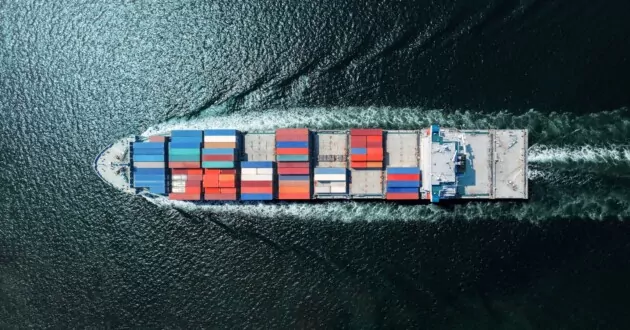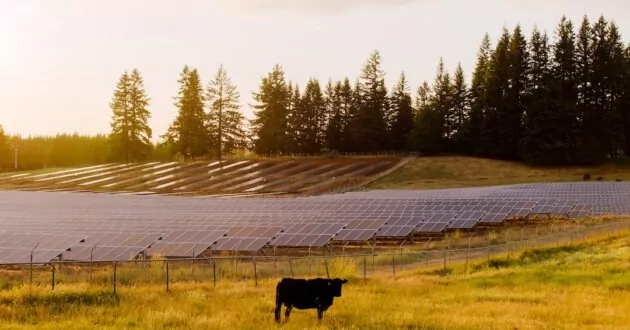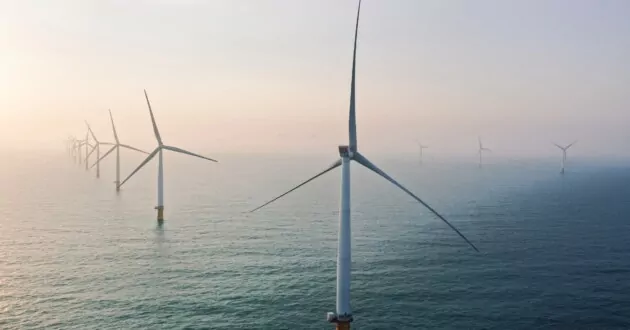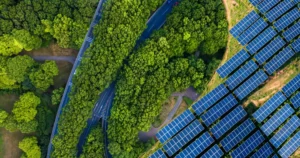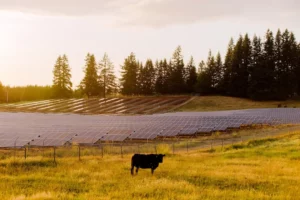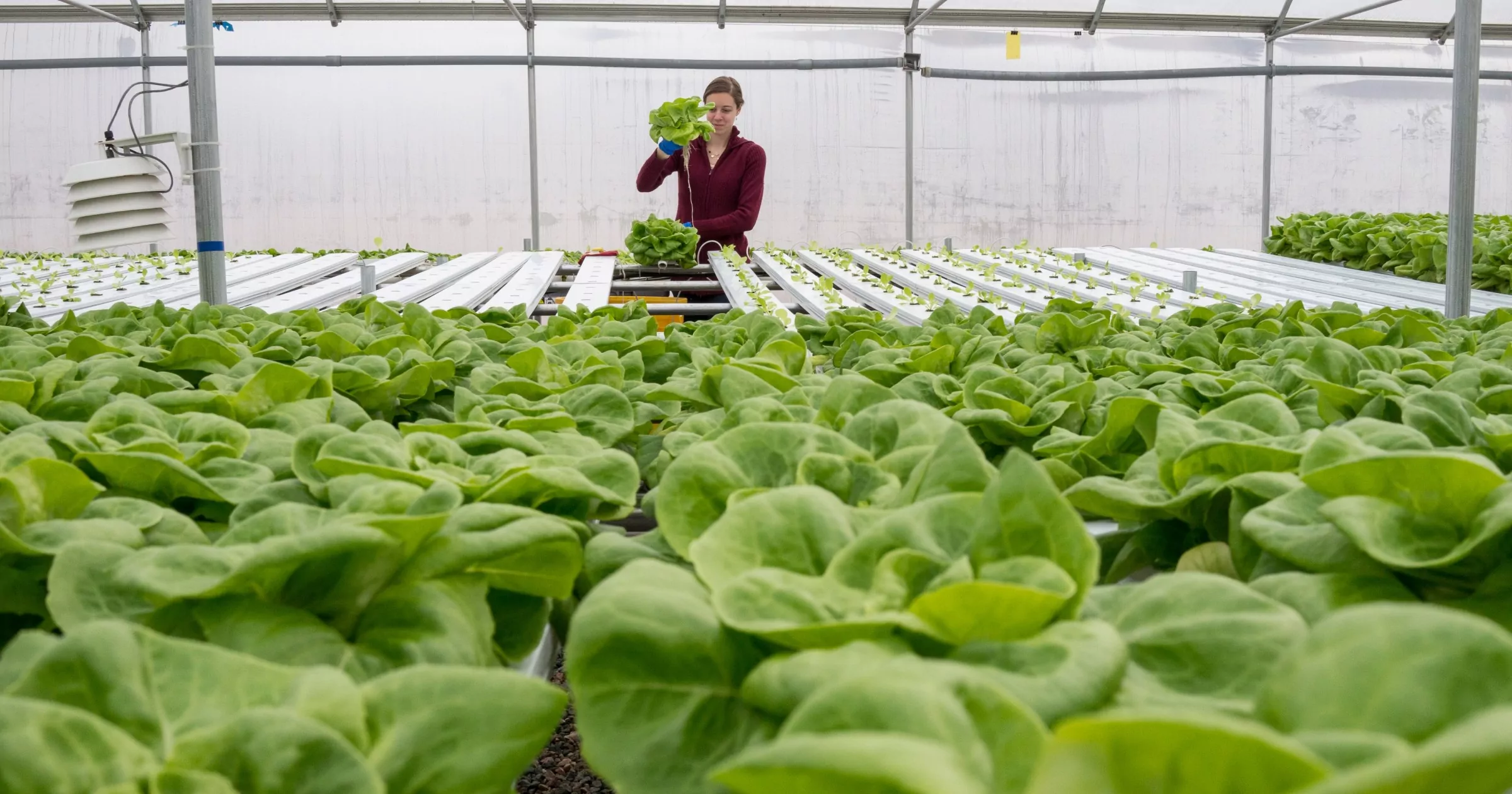
As the world grapples with the realities of climate change, sustainability has evolved from a buzzword to a global imperative. Countries, communities and corporations are seeking ways to slow the pace of change and reduce the impact of human and business activities on the environment. Today, sustainability efforts are being shaped by new urgency and new technology. A 2023 report found that global investment in green or low-carbon energy sources exceeded USD $1 trillion,1 while advanced data collection tools and artificial intelligence (AI) are helping to better monitor emissions and inform sustainability strategy. It’s important to understand how sustainability efforts are impacting global policy, business strategy and our lives in new ways.
What is sustainability?
The United Nations’ Brundtland Commission once defined sustainability as “meeting the needs of the present without compromising the ability of future generations to meet their own needs.”2 At its core, sustainability means creating systems that are self-sustaining and cause minimal harm to the environment and society. Sustainability in business refers to a company’s strategy to reduce negative environmental impact resulting from their operations while ensuring long-term economic growth, social responsibility and protection of natural resources and ecosystems.
Discussions of the topic typically focus on three key areas: environmental sustainability, social sustainability and economic sustainability.
Environmental sustainability: Taking action
Environmental sustainability involves reducing emissions and our environmental footprint to protect ecosystems, biodiversity and natural resources for future generations. It’s about shifting from unsustainable practices towards more eco-friendly alternatives, such as adopting renewable energy sources and increasing energy efficiency.
What companies are doing: Companies are incorporating sustainable practices into their business models. They’re implementing measures to reduce energy usage and adopting renewable energy alternatives where possible to aid efforts against global warming. Businesses may optimize logistics by revaluating supply chain practices; for example, by making transportation and shipping more efficient or using only suppliers that embrace sustainable practices. They may also minimize waste by transitioning from single-use packaging to sustainable materials and biodegradable or recyclable alternatives, thereby reducing landfill contributions.
What countries are doing: Many countries are making changes in line with the goals of the Paris Agreement, a landmark international treaty negotiated at the 2015 United Nations Climate Change Conference (COP21) to limit the impact of greenhouse gas emissions. They’re encouraging the transition from fossil fuels to renewable energy sources, investing in renewable energy infrastructure such as solar panels, and implementing policies to promote energy efficiency. Sweden, for example, aims to be fossil fuel-free by 2040, while in Denmark, over 40% of electricity is generated from wind turbines. Countries and international bodies are also promoting environmental protection initiatives aimed at preserving biodiversity and ecosystems.
What communities are doing: On a grassroots level, individuals and communities are adopting practices like recycling and urban gardening to reduce their environmental impact. They’re also supporting renewable energy initiatives and advocating for environmental conservation.
Social sustainability: Putting people first
Social sustainability focuses on improving the well-being of individuals and making a positive impact on communities. It involves social responsibility towards stakeholders, including employees, customers and the communities in which businesses operate. It often entails efforts like fair trade practices, investing in local economies, ensuring safe working conditions and adherence to ESG (Environmental, Social, and Governance) metrics.
What companies are doing: Corporate sustainability programs often incorporate social sustainability goals. They focus on ethical labor practices that promote fair wages, safe working conditions and equal opportunities for all employees. They may also invest in education, healthcare and other social services in their local communities. Some businesses are also working to meet growing consumer demand for sustainability by creating programs that allow their customers to make more sustainable choices; for by using recycled materials and offering take-back programs for outdated products.
What countries are doing: Countries worldwide are implementing policies promoting social equity. They’re focusing on improving access to education and healthcare, promoting efforts to protect human rights and addressing social issues such as poverty and inequality through social programs. Many are seeking ways to improve quality of life through sustainable city planning, including creating affordable housing, improving public transportation and developing green spaces. National and international bodies may also promote social sustainability through cultural preservation and government transparency.
What communities are doing: Individuals and communities are participating in sustainability initiatives such as carpooling programs, which reduce the collective carbon footprint and foster a sense of community among participants, or volunteering in local projects that address inequality, food waste and other issues. They may also support social sustainability through community engagement initiatives aimed at marginalized communities, or instituting health and wellbeing programs.
Economic sustainability: Growth for good
Economic sustainability is about fostering growth and development in a way that benefits both business’ bottom line and the environment. It involves promoting long-term economic growth without adversely impacting social, environmental and cultural aspects of the community. This might include initiatives such as improving supply chain management to reduce waste and promote efficiency, or investing in eco-friendly technologies or products, which can open new markets and drive revenue growth.
What companies are doing: Many companies are making their supply chains more sustainable by sourcing materials responsibly, reducing waste, and promoting fair labor practices. For example, retailers pursuing economic sustainability goals may seek goods made from recyclable materials and suppliers that ensure fair wages and safe working conditions in their factories. In the agricultural industry, replacing synthetic fertilizers and pesticides with organic alternatives may help maintain long-term soil health, thereby enabling food security for future generations while reducing overall environmental footprint.
What countries are doing: Countries are striving to achieve the United Nations’ Sustainable Development Goals, which provide a roadmap for sustainable economic growth. They’re investing in sustainable infrastructure, promoting innovation and implementing policies to promote fair trade. They may also adopt education initiatives that promote job training and skills building to help citizens adapt to a changing economic environment.
What communities are doing: Individuals and communities contribute by supporting local businesses and practicing responsible consumption. They’re investing in sustainable products and services, and advocating for economic policies that promote sustainability. Many are building up a local sharing economy and embracing circular economic practices (like recycling and upcycling) to reduce waste.
Implementing sustainability goals through technology
Today, technology plays a pivotal role in helping countries, businesses and communities achieve their sustainability goals. AI-powered systems are helping farmers optimize irrigation and reduce water consumption. Blockchain technology is being used to provide supply chain transparency, ensuring products are sustainably sourced. Such technological advancements are not only making it easier to implement sustainable solutions but also transforming them into efficient and cost-effective solutions.
For both major corporations and smaller businesses, the growing need to meet ESG (environmental, social and governance) goals and comply with a complex web of mandatory reporting requirements is driving interest in better ways to capture and analyze data about emissions and operations. For instance, a company embracing sustainable business practices and seeking to reduce its greenhouse gas emissions may invest in ways to monitor energy consumption and track carbon emissions; this way, it can optimize usage, identify how energy-efficient equipment or clean energy sources may help and more easily meet reporting requirements.
Sustainability will be a formative force in coming years; with new tools and technologies in hand, organizations can find new ways to use it to reach their own goals—and a more sustainable future.
Sustainability made simple
Achieving your organization’s sustainability goals requires good data. With IBM® Envizi sustainability management software, you get a simple way to capture and track disparate data on ESG initiatives in one place.
Explore Sustainability Program Tracking with IBM Envizi1 Global Low-Carbon Energy Technology Investment Surges Past $1 Trillion for the First Time, BloombergNEF, January 2023.
2 Sustainability, United Nations, January 2024.
Was this article helpful?
YesNo
IBM Newsletters
Get our newsletters and topic updates that deliver the latest thought leadership and insights on emerging trends.Subscribe now More newsletters
- SEO Powered Content & PR Distribution. Get Amplified Today.
- PlatoData.Network Vertical Generative Ai. Empower Yourself. Access Here.
- PlatoAiStream. Web3 Intelligence. Knowledge Amplified. Access Here.
- PlatoESG. Carbon, CleanTech, Energy, Environment, Solar, Waste Management. Access Here.
- PlatoHealth. Biotech and Clinical Trials Intelligence. Access Here.
- Source: https://www.ibm.com/blog/sustainability-use-cases/
- :has
- :is
- :not
- :where
- $UP
- 00
- 1
- 2%
- 2015
- 2023
- 2024
- 2040
- 26
- 28
- 29
- 30
- 300
- 31
- 39
- 4
- 40
- 400
- 42
- 5
- 6
- 7
- 72
- 8
- 9
- 91
- a
- ability
- About
- access
- Achieve
- activities
- adapt
- address
- addressing
- adherence
- adopt
- Adopting
- advanced
- advancements
- adversely
- Advertising
- advocating
- affordable
- affordable housing
- against
- Agreement
- Agricultural
- AI
- Aid
- aimed
- aims
- AIR
- All
- allow
- also
- alternatives
- among
- amp
- analytics
- analyze
- and
- Announcements
- ARE
- areas
- around
- article
- AS
- aspects
- At
- author
- back
- BE
- become
- being
- benefits
- BEST
- Better
- Blog
- blogs
- Blue
- bodies
- both
- Bottom
- Building
- burned
- business
- business practices
- businesses
- but
- button
- buzzword
- by
- C-suite
- CAN
- Canada
- capture
- carbon
- carbon dioxide
- carbon emissions
- carbon footprint
- card
- Cards
- CAT
- Category
- Cause
- causes
- chain
- chains
- change
- Changes
- changing
- Channel
- check
- choices
- circles
- circular
- CIS
- Citizens
- City
- class
- clean
- clean energy
- Climate
- Climate change
- Cloud
- co2
- Coal
- Coast
- collection
- Collective
- color
- coming
- commission
- Communities
- community
- Companies
- company
- Company’s
- complex
- comply
- comprises
- compromising
- Concern
- conditions
- Conference
- CONSERVATION
- consideration
- considered
- consumer
- consumption
- Container
- Containers
- continue
- contribute
- contributions
- conversations
- Core
- Corporate
- Corporations
- cost-effective
- countries
- covering
- cow
- Creating
- CSS
- cultural
- custom
- Customers
- data
- Date
- Default
- defined
- definitions
- deliver
- Demand
- Denmark
- description
- developing
- Development
- different
- disparate
- distinct
- do
- drive
- driving
- easier
- easily
- Eco-friendly
- Economic
- Economic growth
- economies
- economy
- Ecosystems
- Education
- efficiency
- efficient
- efforts
- electricity
- embrace
- embracing
- emerging
- Emissions
- employees
- enabling
- encouraging
- energy
- Energy Consumption
- energy efficiency
- engagement
- ensure
- ensuring
- Enter
- Environment
- environmental
- Environmental Sustainability
- episode
- equal
- equipment
- equity
- ESG
- Ether (ETH)
- ethical
- Every
- evolved
- example
- examples
- exceeded
- Exit
- expectations
- factories
- fair
- Fair Trade
- false
- faster
- fastest
- Featuring
- field
- Find
- finite
- First
- Focus
- focuses
- focusing
- follow
- following
- fonts
- food
- Footprint
- For
- Force
- fossil
- fossil fuels
- Foster
- fostering
- found
- from
- fuels
- future
- GAS
- generated
- generations
- generator
- get
- Global
- global investment
- global warming
- Goals
- good
- goods
- governance
- Government
- grassroots
- greatest
- Green
- Green spaces
- greenhouse gas
- Greenhouse gas emissions
- Grid
- Growing
- Growth
- guide
- hand
- harm
- harmful
- Harvesting
- Heading
- Health
- healthcare
- height
- help
- helpful
- helping
- here
- housing
- How
- HTTPS
- human
- human rights
- hydrogen
- IBM
- IBM Cloud
- ICO
- ICON
- identify
- identifying
- image
- Impact
- impacting
- imperative
- implement
- implementing
- important
- improve
- improving
- in
- inaccessible
- include
- Including
- incorporate
- incorporating
- increasing
- index
- individuals
- industry
- Inequality
- inform
- Infrastructure
- initiatives
- Innovation
- insights
- instance
- Intelligence
- interest
- International
- into
- Invest
- investing
- investment
- involves
- issues
- IT
- ITS
- January
- Job
- jpg
- just
- Key
- Key Areas
- known
- labor
- landmark
- large
- latest
- Leadership
- Level
- lies
- Life
- like
- LIMIT
- Line
- Lives
- local
- local businesses
- locale
- logistics
- long-term
- low-carbon
- made
- Main
- maintain
- major
- make
- Making
- management
- mandatory
- many
- Markets
- materials
- max-width
- May..
- means
- measures
- Meet
- methane
- Metrics
- might
- min
- minimal
- minimize
- minutes
- Mobile
- models
- Monitor
- more
- more efficient
- most
- moving
- National
- Nations
- Natural
- Natural Gas
- Navigation
- Need
- needs
- negative
- negotiated
- net
- New
- news
- Newsletters
- nothing
- now
- of
- off
- offering
- often
- Oil
- on
- once
- ONE
- only
- open
- operate
- Operations
- opportunities
- Optimize
- optimized
- or
- organic
- organizations
- Other
- our
- out
- outdated
- outside
- over
- overall
- own
- Pace
- packaging
- page
- panels
- paris
- Paris Agreement
- part
- participants
- participating
- past
- People
- person
- perspectives
- PHP
- pivotal
- Place
- planning
- plato
- Plato Data Intelligence
- PlatoData
- plays
- Plugged
- plugin
- policies
- policy
- position
- positive
- possible
- Post
- potential
- Poverty
- practices
- present
- preservation
- preserving
- primary
- process
- procurement
- procurement process
- produce
- Produced
- Products
- Products and Services
- Program
- Programs
- projects
- promising
- promote
- promoting
- protect
- protection
- provide
- public
- public transportation
- published
- pursuing
- Putting
- quality
- RE
- reach
- Reading
- realities
- recent
- recycled
- recycling
- reduce
- reduce waste
- reducing
- reducing emissions
- refers
- region
- release
- Renewable
- renewable energy
- report
- Reporting
- Requirements
- requires
- Resources
- responsibility
- responsible
- responsibly
- responsive
- resulting
- retailers
- revenue
- revenue growth
- rights
- rising
- roadmap
- robots
- Role
- safe
- Screen
- scripts
- security
- Seek
- seeking
- selecting
- sense
- seo
- Series
- servers
- Services
- shaped
- shaping
- sharing
- sharing economy
- SHIFTING
- ship
- Shipping
- Simple
- site
- sits
- skills
- slow
- small
- smaller
- Social
- social issues
- Society
- Software
- soil
- solar
- solar panels
- Solutions
- some
- sourced
- Sources
- Sourcing
- spaces
- speeds
- Sponsored
- squares
- stakeholder
- stakeholders
- start
- stay
- Strategy
- striving
- subscribe
- such
- Sun
- suppliers
- supplies
- supply
- supply chain
- supply chain management
- Supply chains
- support
- Supporting
- sure
- Surges
- Sustainability
- sustainable
- Sustainable Development
- sustainable future
- sustainably
- SVG
- Sweden
- synthetic
- Systems
- taking
- teams
- tech
- technological
- Technologies
- Technology
- tertiary
- than
- thanks
- that
- The
- the world
- their
- Them
- theme
- themselves
- thereby
- they
- think
- this
- thought
- thought leadership
- three
- Through
- time
- Title
- to
- today
- too
- tools
- top
- topic
- Topics
- towards
- track
- Tracking
- trade
- traditional
- Training
- transforming
- transition
- transitioning
- Transparency
- transportation
- Trends
- Trillion
- type
- types
- typically
- UN
- understand
- United
- united nations
- unsustainable
- Updates
- urban
- urgency
- URL
- Usage
- USD
- use
- used
- using
- Video
- View
- Virtual
- Volunteering
- W
- wages
- Waste
- Water
- Way..
- ways
- we
- web
- wellbeing
- What
- when
- which
- while
- WHO
- widely
- will
- wind
- with
- within
- without
- WordPress
- working
- world
- world’s
- worldwide
- written
- years
- you
- Your
- youtube
- zephyrnet
- zero

